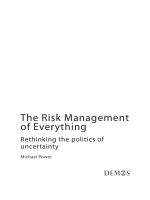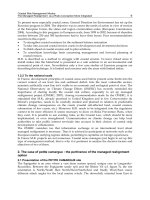The Risk Management of Everything Rethinking the politics of uncertainty docx
Bạn đang xem bản rút gọn của tài liệu. Xem và tải ngay bản đầy đủ của tài liệu tại đây (309.37 KB, 74 trang )
The Risk Management
of Everything
Rethinking the politics of
uncertainty
Michael Power
About Demos
Demos is a greenhouse for new ideas which can improve
the quality of our lives. As an independent think tank, we
aim to create an open resource of knowledge and
learning that operates beyond traditional party politics.
We connect researchers, thinkers and practitioners to an
international network of people changing politics. Our
ideas regularly influence government policy, but we also
work with companies, NGOs, colleges and professional
bodies.
Demos knowledge is organised around five themes,
which combine to create new perspectives. The themes
are democracy, learning, enterprise, quality of life and
global change.
But we also understand that thinking by itself is not
enough. Demos has helped to initiate a number of
practical projects which are delivering real social benefit
through the redesign of public services.
We bring together people from a wide range of
backgrounds to cross-fertilise ideas and experience. By
working with Demos, our partners develop a sharper
insight into the way ideas shape society. For Demos, the
process is as important as the final product.
www.demos.co.uk
First published in 2004
© Demos
Some rights reserved – see copyright licence for details
ISBN 1 84180 127 5
Typeset by Land & Unwin, Bugbrooke
Designed by R&D&Co
Printed by Hendy Banks,London
For further information and
subscription details please contact:
Demos
The Mezzanine
Elizabeth House
39 York Road
London SE1 7NQ
telephone: 020 7401 5330
email:
web: www.demos.co.uk
Open access.Some rights reserved.
As the publisher of this work,Demos has an open access policy which enables anyone to access our
content electronically without charge.
We want to encourage the circulation of our work as widely as possible without affecting the ownership
of the copyright,which remains with the copyright holder.
Users are welcome to download,save,perform or distribute this work electronically or in any other format,
including in foreign language translation without written permission subject to the conditions set out in
the Demos open access licence which you can read at the back of this publication.
Please read and consider the full licence.The following are some of the conditions imposed by the licence:
● Demos and the author(s) are credited;
● The Demos website address (www.demos.co.uk) is published together with a copy of this policy
statement in a prominent position;
● The text is not altered and is used in full (the use of extracts under existing fair usage rights is not
affected by this condition);
● The work is not resold;
● A copy of the work or link to its use online is sent to the address below for our archive.
Copyright Department
Demos
Elizabeth House
39 York Road
London
SE1 7NQ
United Kingdom
c
Yo u are welcome to ask for permission to use this work for purposes other than those covered by the
Demos open access licence.
Demos gratefully acknowledges the work of Lawrence Lessig and Creative Commons which inspired our
approach to copyright.The Demos circulation licence is adapted from the ‘attribution/no derivatives/non-
commercial’version of the Creative Commons licence.
To find out more about Creative Commons licences go to www
.creativecommons.org
Contents
Acknowledgements 7
1. Introduction: The risk management explosion 9
2. The state as risk manager 17
3. Turning organisations inside out: Internal control
becomes risk management 24
4. Anxiety and classification:The invention of
operational risk 29
5. What’s in a name? Reputational risk and the
transformation of social responsibility 32
6. Explaining the risk management of everything:
Function, fashion and fear 37
7. Out of control? Avoiding the risks of risk management 43
8. Conclusions and suggestions 59
Notes 66
Demos 7
This essay began life as an inaugural professorial lecture, ‘The new
risk management’, given at the London School of Economics in
December 1999. The author thanks the Trustees of the Institute of
Chartered Accountants in England and Wales, and the Economic and
Social Research Council for financial support. The author is also
grateful for helpful comments from Tom Bentley, Julia Black, Rachel
Briggs, Robert Bruce, Bill Durodie, Martin Evans, Bridget Hutter, Jimi
Irwin, Sue Mayer, Caroline Muller, Nick Pidgeon, Henry Rothstein,
Andy Stirling, James Strachan, Christopher Swinson, James Wilsdon
and Brian Wynne. Particular thanks are due to Paul Skidmore and
Eddie Gibb of Demos and to Julie Pickard.
Michael Power
June 2004
Michael Power is P.D.Leake Professor of Accounting and a Director of
the ESRC Centre for the Analysis of Risk and Regulation (CARR) at
the London School of Economics, where he has worked since 1987.
He is a fellow of the Institute of Chartered Accountants in England
and Wales (ICAEW) and an associate member of the UK Chartered
Institute of Taxation. He has held visiting fellowships at the Institute
for Advanced Study, Berlin and All Souls College, Oxford. Research
interests focus mainly on the changing relationship between financial
accounting, auditing and risk management. He is author of The Audit
Explosion (Demos, 1994) and The Audit Society: Rituals of Verification
(Oxford University Press, 1999), which has been translated into
Italian and Japanese, and is currently being translated into French.
The Risk Management of Everything
8Demos
1. Introduction:
The risk management explosion
Demos 9
Can we know the risks we face, now or in the future? No, we
cannot: but yes, we must act as if we do.
1
Risk management and risk ‘talk’ are all around us. The risk-based
description of organisational life is conspicuous. Not only private
sector companies, but hospitals, schools, universities and many other
public organisations, including the very highest levels of central
government, have all been invaded to varying degrees by ideas about
risk and its management.
Why has this happened and what are its consequences?
Is this just one more management craze with questionable
benefits and potentially adverse effects?
Or is it a rational response to an increasingly risky world?
Is the growing organisational preoccupation with risk
management a symptom of failing control in a complex
environment, or is it a basis for re-focusing
entrepreneurial energy?
Governments and large organisations must always act as if
they are in control, so is risk management simply the new
game of reassurance, an audit explosion in new clothes, or
a basis for innovation and change?
And what of the general public and its relationship to this ubiquitous
risk management? Does it enhance public confidence in private and
public sector organisations, or is it simply a managerial smokescreen,
deflecting attention from the more fundamental fact that individuals
are increasingly alone with risk, unable to trust the very institutions
designed to absorb it on their behalf?
These questions motivate an analysis of the ‘risk management of
everything’, a motif for one of the major public policy challenges of
the early twenty-first century.
Risk talk and risk management practices
Risk talk and risk management practices, rather like auditing in the
1990s, embody the fundamentally contradictory nature of organ-
isational and political life. On the one hand there is a functional and
political need to maintain myths of control and manageability,
because this is what various interested constituencies and stake-
holders seem to demand. Risks must be made auditable and governable.
On the other hand, there is a consistent stream of failures, scandals
and disasters which challenge and threaten organisations, suggesting
a world which is out of control and where failure may be endemic,
and in which the organisational interdependencies are so intricate
that no single locus of control has a grasp of them.
Risk management organises what cannot be organised, because
individuals, corporations and governments have little choice but to
do so. The risk management of everything holds out the promise of
manageability in new areas. But it also implies a new way of allocating
responsibility for decisions which must be made in potentially
undecidable situations.
Who bears the risk?
Many agencies in society which have traditionally played the role of
taking risk on behalf of the public, such as insurance companies,
financial services organisations and financial professionals, seem in
fact to be handing risks back as part of their own risk management.
Indeed, the risk management of everything is characterised by the
The Risk Management of Everything
10 Demos
growth of risk management strategies that displace valuable – but
vulnerable – professional judgement in favour of defendable process.
The state’s orientation to risk has also been transformed. The UK
government has recently become only too aware of big system and
project failures, and the vulnerabilities they create. In the fields of
energy provision, public transport, health, financial services and
large-scale infrastructure there have been major public crises.
Following the BSE crisis, and failures in school examinations and
passport applications systems, risk management ideas have moved to
the heart of government itself. Risk management is now at the centre
stage of public service delivery and is a model of organisation in its
own right.
Notwithstanding these efforts, faith in the role of the state as
absorber, collectiviser and redistributor of risk may be in decline.
Government is suspected of substituting risk management for
political argument.
The rise of risk management
Risk management is much more than a technical analytical practice;
it also embodies significant values and ideals, not least of
accountability and responsibility. Historically, a public politics of risk
management, particularly in the field of health, has been concerned
with the transparency and accountability of scientific expertise in
decisions about risk acceptance. Since the mid-1990s, risk manage-
ment and private corporate governance agendas have become
intertwined, if not identical. Since 1995 (the year of the collapse of
Barings bank and of the Brent Spar crisis for Shell), being a ‘good’
organisation has become synonymous with having a broad and
formal risk management programme. Risk analysis, the traditional
technical home territory of risk management, has been subsumed
within a larger accountability and control framework.
2
An expanding knowledge base for risk management
Evidence for this transformation in the meaning and scope of risk
and its management is to be found in a policy, business and
Introduction
Demos 11
regulatory literature explosion since the mid-1990s, providing a
knowledge base from which corporations and government can draw.
3
In the UK, slender guidance documents such as the ‘Turnbull Report’
have become powerful points of reference in a reform process which
has seen the emergence of standardised organisational forms, such as
risk committees, appearing throughout the private and public
sectors.
4
A casual internet search using the term ‘risk management’
yields numerous professional articles in areas as diverse as
anaesthetics and charities, and all seem to adopt a similar framework.
Multiple text books and articles on ‘enterprise’ and ‘integrated’ risk
management have been published since the late 1990s, a period which
has seen the flowering of many new practitioner magazines with the
word ‘risk’ in their titles, and the conscious amendment of extant
titles to include the word risk.
5
Existing occupational associations,
particularly those with strong foundations in insurance, a traditional
stronghold of risk management thinking, have also taken up a generic
risk management agenda and their websites have become reference
points for new risk management thinking which is rapidly diffused.
6
This explosion of risk management ideas and blueprints is a
collection of aspirations and ideas, a rhetoric which may be well
ahead of practice. Unlike the expansion of auditing in the 1980s,
states and politicians do not appear to have been major direct
pressures for change, although they are adopters of risk management
thinking. New models of organisation and regulation are emerging
from various private sector sources, and consultants and professional
service firms are conspicuously the creators of new templates for
managing risk, sensing opportunities for using risk to re-define their
strategic significance and value.
7
The risk management of everything
Origins
This phenomenal expansion of the risk industry reflects a number of
different but convergent pressures for change in organisational
practices for dealing with uncertainty.There has been a fusion of
The Risk Management of Everything
12 Demos
ideas about organisational governance and corporate responsibility.
New models of regulation are in vogue, and there have been changes
in attitude to the traditional mechanics of risk transfer with a greater
accent on risk communication. In addition, technological changes in
information systems have created new risk management possibilities.
Scandals and crises of the past ten years have also been catalysts for
the emergence of a conception of risk management with wide scope,
unifying traditionally separate areas, such as health and safety,
insurance and project management in a single model, but also
absorbing new objects of concern.
8
Even concepts of national security
and ideas of ‘preventative’ military action are being thought of within
the conceptual architecture of risk management.
Risk has entered private and public sector management thinking to
become an organising concept as never before.
9
Since the mid-1990s
considerable effort has been expended on making risk management
into a value proposition and in both private and public sectors the
concept of risk is being enrolled in a new focus on outcomes and
performance.In the private sector this is visible in efforts to link
investments in control activities to organisational objectives and
value creation within frameworks for enterprise-wide risk
management (ERM). In the public sector ‘risk’, rather like customer
responsiveness, is emerging as the basis for self-challenging
management practices in the absence of direct competitive pressures.
However, while these rhetorics of value, integration and
innovation may be upbeat, it will be argued that these aspirations
must overcome the overwhelming tendency for the new risk
management to exacerbate process.In both the public and private
sectors, risk management is part of a new style of organisational
discipline and accountability. Herein lies one of the major risks of the
risk management of everything.
What is risk?
The risk management of everything is intended to suggest that more
and more events and things are being seen and described in terms of
‘risk’, even though the concept remains elusive, contested and
Introduction
Demos 13
‘inherently controversial’.
10
Var ious specialist definitions and
classifications exist in the attempt to secure its meaning, and these
definitions reflect specific institutional interests. In some traditions
(health and safety), risk is equated with hazards and dangers; for
others (finance) it is a matter of volatility in expected outcomes, both
negative and positive. However, the very vagueness and ambiguity of
‘risk’, a fact which troubles expert commentators, is in fact a necessary
feature of its widespread impact. From this point of view, the
question ‘what is risk?’ is less important than the question: ‘how do
we know risk and what are the social and economic institutions
which embody that knowledge?’.
11
It has been famously suggested that we live in a ‘risk society’ in
which individuals are ever more conscious of self-produced or
manufactured risk.
12
Although, it is debatable whether the world is
‘more risky’ or more objectively dangerous now than in the past,
more possible outcomes in the world are now regarded as amenable
to human decision and intervention, rather than being in the hands
of the gods.
13
As part of a politics of uncertainty, publics of varying
kinds demand decisions and the right to hold decision-makers to
account. In this view, the problem is to render scientific and other
experts accountable and their judgements publicly transparent. The
public outcry over an alleged link between the MMR vaccine and
autism in children, and the controversy surrounding the now
discredited ‘expert’ testimony of Sir Roy Meadows in child protection
cases, are two recent examples of this politics of uncertainty.
Secondary risk management
But the risk management of everything poses a different agenda of
concern, namely that the experts who are being made increasingly
accountable for what they do are now becoming more preoccupied
with managing their own risks. Specifically, secondary risks to their
reputation are becoming as significant as the primary risks for which
experts have knowledge and training. This trend is resulting in a
dangerous flight from judgement and a culture of defensiveness that
create their own risks for organisations in preparing for, and
The Risk Management of Everything
14 Demos
responding to, a future they cannot know. It will be argued that a ‘new
politics of uncertainty’ is required to counter this trend.
The argument
This essay seeks to describe the institutional shape of the risk
management of everything, to understand its causes and to offer a
critique with suggestions for future policy.
The arguments below are necessarily sweeping and focus largely on
UK examples. Accordingly, their generalisability and comparability
can be questioned. Much work remains to be done in order to
understand the emerging institutionalisation of a new pervasive risk
management through definitions, attributions of responsibility,
communicative structures and accountability demands. It may well
be that the UK context is an exceptional one, characterised by a string
of major failures and an aggressive media.
In the next chapter, the risk management of everything is discussed
in the context of the state’s preoccupation with risk management.
Two key themes are analysed: risk communication and reputation;
and risk-based regulation. This is followed by a discussion of three
critical aspects of the new risk management which have emerged
from the private sector, and which are being imported and adapted by
the state: the emergence of risk-based internal control and its role in
redefining organisational governance and regulation; the invention of
the category of ‘operational’ risk to name a diverse basket of threats to
organisations; the emergence of the category of reputational (and
ethical) risk and the manner in which corporate social responsibility
agendas are being translated by risk management ideas.
From this descriptive anatomy of the new risk management, the
argument seeks in chapter 6 to explain its appearance. It is suggested
that, while the risk management of everything may be a fad, a more
complete explanation appeals to an individualisation process which is
driving risk experts and professionals to focus more on their
personal, legal and reputational risks, rather than on the primary
risks embodied in their formal mission. This pathology of risk
management is further criticised in chapter 7 in terms of four
Introduction
Demos 15
overlapping problem areas: legalisation and trust; the imperialism of
internal control; trust in risk numbers; and the privatisation of public
policy.
In conclusion, the diagnosis provides suggestions for an ‘intelligent
risk management’
14
capable of avoiding these problems. There is also
a plea for a new politics of uncertainty which could support the
public conditions under which the worst side-effects of our
organisational obsession with risk and its management could be
mitigated.
The Risk Management of Everything
16 Demos
2. The state as risk
manager
Demos 17
Modern states play a role that is easy to describe in risk management
terms. They pool and redistribute certain types of risk via health and
welfare systems. Since the nineteenth century they have produced
legislation in a wide variety of areas. As regulatory states, they also
create an increasing number of specific organisations charged with
‘risk regulation’. In the UK it is possible to list the Health and Safety
Executive, The Food Standards Agency, The Financial Services
Authority, The Commission for Health Audit and Inspection and
many other bodies. Although it is plausible to describe the state as if it
had a risk management or insurance function in a general way, state
and related organisations have only recently become self-conscious
and explicit about risk and their risk management agendas, adopting
concepts and standards from private sector blueprints. In the UK, risk
management started to become part of the official self-description
and self-understanding of central government activities in the late
1990s.
This growth of risk talk at the centre of government and in
regulatory organisations may be explained in terms of a growing
consciousness of risk to the state for failure to deliver on public
services. It may also have something to do with public perceptions of
the state as a source of risk in the face of mismanaged crises.
Research has shown that there is very considerable variety in the
manner in which risks are processed by state agencies; the
‘government of risk’ is by no means uniform across problems and
functions, with public perceptions, moral frameworks, institutional
arrangements and the nature of the risk itself giving rise to variation
in ‘risk regulation regimes’.
15
Nevertheless, the new mood of risk in
UK government reveals some common preoccupations which frame
and organise ideas about the management of risk. Two themes
deserve particular attention: communication with the public; and
risk-based regulation.
Risk perception, communication and reputation
Risk perception
An extensive research literature on risk perception exists and the idea
that individuals process and react to dangers in a wide variety of
ways, dependent on many different features of how risk is framed and
presented, is well established. From this point of view, individual
attitudes to risk are far from being a given. Research has informed a
critical project to question the exclusivity of scientific and expert
authority. It challenges highly rationalistic models of risk analysis
which assume away the important psychological and cultural
dimensions of risk understanding. This critique, an early politics of
uncertainty, has only very slowly and selectively been absorbed into
mainstream regulatory thinking.
The 1992 Royal Society report on risk significantly included a
number of these issues, but the synthesis between technical scientific
conceptions of risk analysis and social–psychological analyses of risk
perception was evidently an uneasy and imperfect one.
16
A later
report in the USA was more successful in this integration,
17
and
policy receptivity to risk perception issues has changed in the light of
a number of public crises and scandals. From 1995 ideals of
stakeholder engagement and the importance of communication
began to figure prominently in generic risk management blueprints.
In the UK, the handling of the BSE crisis had a catalytic effect on
government, forcing a recognition of the need to manage risk more
explicitly.
18
In particular, risk communication was accepted as
The Risk Management of Everything
18 Demos
necessary to manage public expectation and its potential
disappointments.
Risk communication
In recent years, risk communication ideas have become normalised in
a number of UK policy documents, notably the Strategy Unit report
in 2002 which has a separate chapter on ‘handling and communi-
cating’ risks to the public. Earlier policy documents by the National
Audit Office translated private sector enterprise risk management
(ERM) ideas into the state domain. The UK Treasury has now
adopted this agenda, establishing risk management guidelines for
government departments, and supporting this with an educational
and cultural change programme headed by ‘risk improvement’
managers (RIMs). In addition, the Treasury Risk Support Team has
absorbed the work of the UK Interdepartmental Liaison Group on
Risk Assessment (UK-ILGRA).
19
This central government initiative in the UK has been described as
one of ‘organised paranoia’. It has the aim of improving the
government’s capacity to spot new risks in incubation. But it is also
reminiscent of, and extends, reform processes begun by the new
public management.
20
Risk is the new concept for challenging the
quality of public services in the absence of real markets.
The widening enfranchisement of, and communication with, lay
publics in the business of risk regulation is itself varied and the extent
to which the process is democratic remains problematic.
21
There has
been debate about the implications of participation and communi-
cation strategies for ‘risk acceptance’ processes. Previously the sole
preserve of expert committees and individuals, the emergence of
demands for consultation and for taking seriously the views of diverse
publics has brought the principles for accepting risk – ‘risk appetite’
in the language of private sector risk management standards – into
public question.
Attitudes to risk vary across individuals, and may be different at
different levels of an organisation.
22
Risk attitudes or appetites may
also vary across different aspects of the same risk, may in reality not
The state as risk manager
Demos 19
correspond to any stated appetite and may change with new or better
information. Policy-makers seeking to aggregate these views before
deciding whether or not to accept a risk therefore face many
difficulties. Not least is the problem of knowing which public
understandings of risk to take seriously and which not.
23
In some
cases, the public may understand risk issues very clearly.
The democratisation of risk policy has also sustained a huge
discussion to do with risk architecture and risk acceptance principles.
The much discussed precautionary principle in its various forms
places the burden of proof on any technological innovation, most
prominently in the case of GM foods, to demonstrate its safety.
Opponents of this principle argue for the importance of innovation
and for the need for some kind of cost–benefit approach to risk
acceptance.
Reputational risk to the state
By extending the scope of risk management practice beyond the
domain of the expert, to embrace and somehow enfranchise lay views
of risk, the state seeks to improve its capacity to handle risk.
According to some commentators, given the indeterminacy of risk
assessment it is essential that public perspectives play a role in the risk
regulation process.
24
But the growing enfranchisement of publics and
stakeholders in risk regulation regimes has much to do with
managing the perceived legitimacy of regulatory activity and
decisions. There is more than a hint that risk communication
strategies are as concerned with managing the secondary or
reputational risk to regulators, public bodies and government as they
are about the primary risk that is to be regulated.
The UK government, like many others, is concerned to manage
public expectations with improved service delivery and project
management.
25
The gap between these expectations and actual
performance constitutes a reputational, and ultimately political risk
for government and its agencies, such as regulatory bodies. Indeed, it
has been argued that the creation of such bodies is itself a strategy by
which government manages its reputational risk.
26
The Risk Management of Everything
20 Demos
Risk-based regulation and the politics of uncertainty
Over time it has become increasingly accepted that regulation is likely
to be more effective and more acceptable if it works with the grain of
private control systems. By harnessing private control activities for
public regulatory purposes, regulatory organisations can be relieved
of much of the economic and epistemic burden of detailed rule-
making, and can focus on overseeing the design and functioning of
local systems.
27
Responsive models of regulation
This ideal model, which is variously described as ‘enforced self-
regulation’, ‘regulated self-regulation’ and ‘meta-regulation’, gives
internal control systems a central role.
28
Examples of the model are
increasingly found in banking regulation (the Basel 2 reforms in
particular), in health and safety regulation, in teaching quality
regulation and many other areas. In theory, regulatory regimes can
become more ‘responsive’ to the self-organisation of regulatees,
whether these are banks or local government service providers. The
self-control activities of organisations have become an essential
component of regulatory agendas which are developing in the
direction of ‘risk-based regulation’. This is a blueprint for the risk
management state.
In a number of domains regulatory bodies have explicitly adopted
risk-based approaches to the organisation of resource allocation.
29
Risk-based regulation is part of being explicit about limited resources
and the need to direct them to where they are needed most, eg failing
schools, unsafe facilities, banks with weak controls. Risk-based
approaches to regulation are simultaneously strategic and goal-
oriented. This conjunction of risk and strategy is fundamental to the
marketing of new approaches to regulation and risk management, in
particular by creating a common vocabulary between regulator and
regulated.
But why does this emerging change in the operating philosophy of
regulatory bodies matter?
The state as risk manager
Demos 21
Risk-based regulation and the politics of uncertainty
Risk-based regulation is the potential site of a new ‘politics of
uncertainty’, an idea discussed in more detail in the final chapter.
Such a politics would be premised on the acceptance that failures and
accidents are possible in complex environments, even with the most
competent, ethical and expert oversight possible. Given the emphasis
being placed on the importance of innovation to economic growth
and prosperity, it might even be said that some failure is necessary.
30
Risk-based regulation necessarily embodies the idea that failures are
possible. However, the degree to which regulators and politicians are
able to be publicly explicit about this will vary according to the
perceived reputational and political risks of doing so.
Political discourses of ‘zero-tolerance’ sit uneasily with a risk-based
ethos. In addition, an event such as the demise of Equitable Life,
which could be regarded as ‘tolerable’ from the impersonal point of
view of systemic financial risk, was in fact experienced by large
numbers of people as a life-changing catastrophe – and reflected in
the media as such. People also feel differently about specific risks, eg
public attitudes to deaths on the road differ from attitudes to deaths
on public transport. All this means that ex ante public acceptance of
the possibility of failure can never control ex post public reaction to
actual failure.
The prospects for a new politics of uncertainty are also threatened
because risk-based regulation can be used as part of regulators’ own
secondary, or reputational risk management process. Indeed,
regulatory organisations must handle the uncertainties and
volatilities of the political environment – political risk. From this
point of view, risk-based regulation is ambivalent. On the one hand it
contains the seeds for a new risk politics; on the other it may
exacerbate the risk management of everything.
The example of the UK General Medical Council (GMC) is
instructive. The official inquiry into the serial murders by Harold
Shipman exposed weaknesses and deficiencies in the GMC’s
regulatory practices, particularly its processes for the investigation of
errors and administration of complaints, and its cultural bias in
The Risk Management of Everything
22 Demos
favour of doctors. At the time of writing it seems likely that there will
be much greater formalisation of the ‘fitness to practice’ regulations
for UK doctors. In a critical climate, a publicly explicit risk-based
approach to the regulation of doctors is unlikely to be acceptable.
However, it is likely that a new regime will in fact operate in this way.
More importantly, the reforms will increase the burden of ‘auditable
process’ in the medical field. The GMC is seeking to rebuild its
regulatory reputation and doctors will intensify their personal risk
management strategies. Whether any of this would have prevented
any or all of the Shipman murders is an unknown.
Summary
The regulatory state is becoming a risk management state. Operating
in an indirect manner, states are trading depth for breadth in their
operations, functioning via an enormous variety of risk regulation
regimes. Although there is considerable cross-sectional variation in
practices, two key themes are evident: an increasing emphasis on
communication with different publics as a basis for managing
reputation; and a trend for more explicitly risk-based approaches to
regulation and control in a widening number of areas. Above all the
risk management state depends on internal control systems in
organisations which proceduralise risk.
The state as risk manager
Demos 23
3. Turning organisations
inside out:
Internal control becomes risk
management
24 Demos
A conspicuous feature of the risk management of everything has been
the rise of the internal control system. Such systems translate primary
or real risks into systems risks, such as early warning mechanisms and
compliance violation alerts. Thus many risks can be, and are being,
operationalised as organisational processes of control, eg BSE and
farm management systems, GM crops and traceability systems,
earthquakes and emergency services/building regulations, terrorism
and the organisation of security and intelligence services. Clinical risk
management was originally conceptualised in terms of accidental
harms done to patients during the care delivery process; it has
subsequently become part of a regulatory regime concerned with the
effectiveness of health care in general, a matter of health care
organisation rather than specific clinicians.
31
Indeed, risk
management was one of the five pillars of clinical governance
informing the work of the Commission for Health Improvement in
the UK (now replaced by the Commission for Health Audit and
Inspection).
32
Organisational translations of risk into internal controls are
necessary conditions of possibility for risk-based regulation, and
hence for the successful operation of the risk management state.
Internal control is thereby the state in organisational miniature.
The topic of internal control in organisations is hardly likely to set
the pulses racing. Indeed, for many years this subject has been a
private matter for managers, a dry technical domain of control
specialists with checklists, evaluation questionnaires and a whole host
of other instruments. Internal control could even be described as a
kind of organisational common sense. Entities as diverse as private
corporations, corner shops, clubs and churches, all require minimum
financial and non-financial control systems to keep track of money
and related activities. But far from being a private organisational
matter, the effectiveness of internal control systems is now an issue
for public policy and formal law.
33
In short, private internal control
has come to play a very significant external public role; organisations
ranging from major companies to universities are being turned
‘inside out’ in its name, and this more than anything else drives a risk
management explosion which demands the externalisation and
justification of organisational control arrangements.
A brief history of internal control
The transformation in the position and status of internal control
began in the 1980s in the financial services sector and became more
pronounced and generic during the 1990s. A critical event in the UK
was the collapse of the Maxwell empire and subsequent reactions
which led to the publication of the Cadbury Code on Corporate
Governance in 1992.
34
Corporate governance, traditionally
understood in the context of markets for corporate control, became
re-conceptualised as a matter of internal organisational structure and
design. The Cadbury Code, though formally voluntary, established
the principle that senior management are responsible for the
maintenance of an internal control system. The general principles in
the UK code, and its subsequent refinements, have been hugely
influential, shaping generic initiatives elsewhere, including at the
transnational level.
35
In the USA, a parallel critical event was the
publication of the COSO document on internal control, following a
congressional inquiry into fraudulent financial reporting.
36
Internal
control was re-defined broadly to cover not just controls relating to
financial accounting, the typical focus of auditors, but also regulatory
compliance matters and operations more generally. This expansion
Turning organisations inside out
Demos 25









